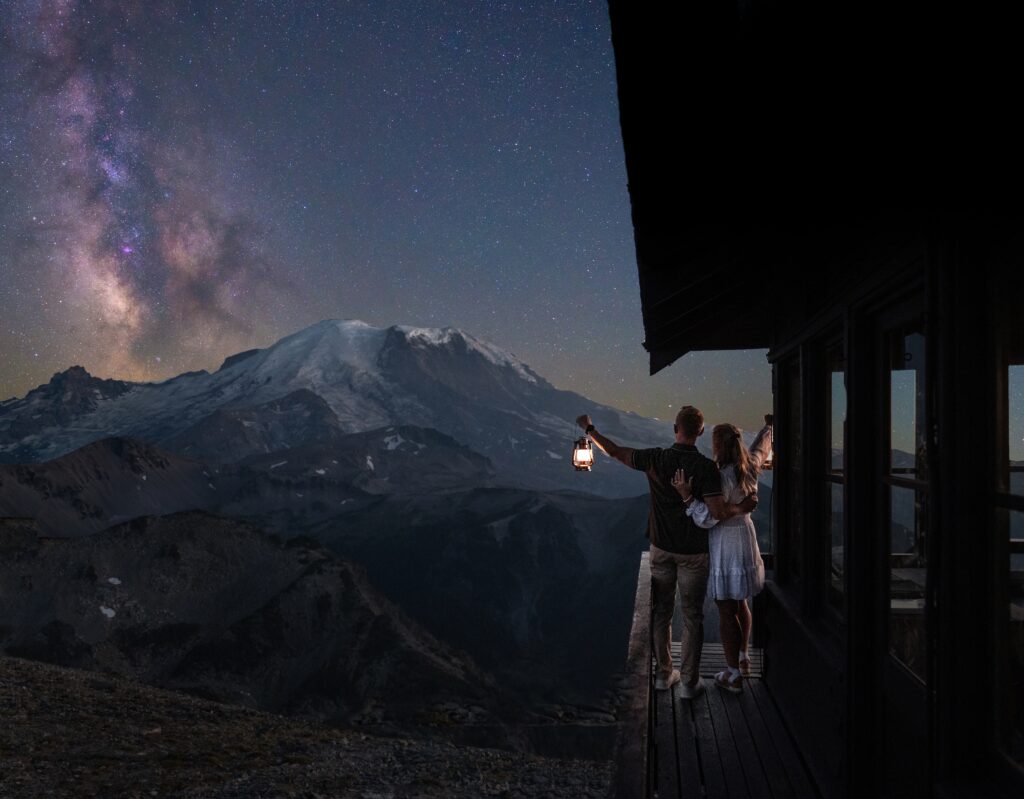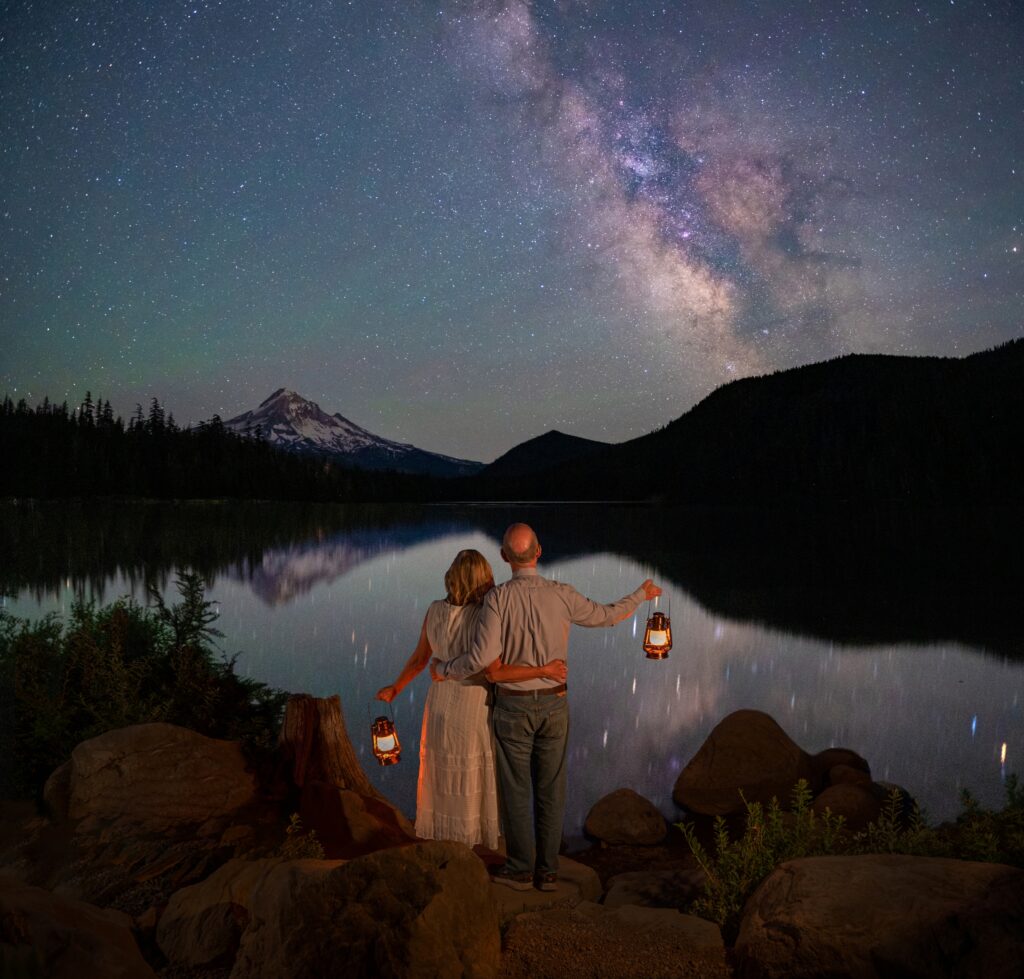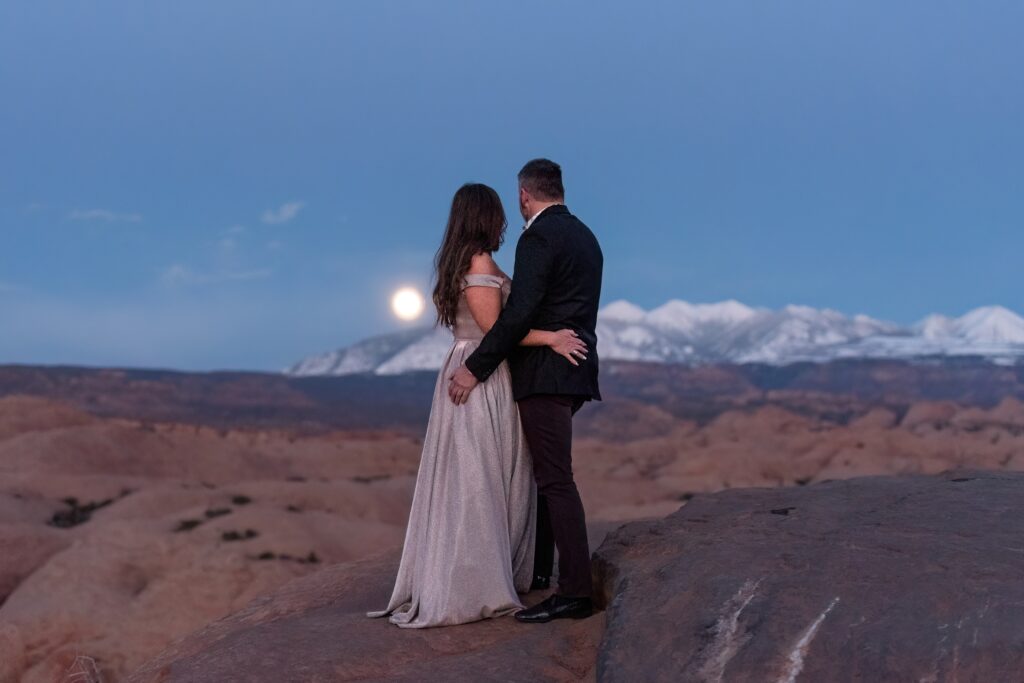
The Milky Way is visible in the Northern Hemisphere from March through October. However, the beauty of the night sky is available YEAR-ROUND! There is a full moon about once every month (once every 29.5 days), and starry skies full of sparkling constellations are always beautiful.
Based on your adventure personality, your location, your ability level, and the type of photos you’re dreaming of, we will work together to craft the perfect package on a date that makes sense for you.
Read on to find out what each month of the year has to offer in terms of night sky photography potential.*
*Times given reflect general latitude of the Pacific Northwest. Locations at different latitudes will have slightly different timelines. Check out the links at the bottom to view sunrise/sunset times for other locations.
January
Have you ever wanted portraits under a starry sky with the bright snow reflecting all around you? I LOVE photographing in snow because the snow takes on all the colors of the sky, from night until sunrise. You will probably be cold, but I can guarantee it’ll be the most rad “THAT WAS SO FREAKING WORTH IT” experience ever. Envision cozying up to a campfire burning in the snow as the stars come out – winter perfection. Cross country skiing at night, anyone?
Sunrise: 7:45 AM | Sunset: 5:00 PM
February
Much like January, February is snowy and cold. Think about bundling up in faux furs, stylish winter coats, earmuffs, and cozy hats… hand warmers stuffed in every pocket. When you witness the colors of sunrise crest over mountain peaks and splash onto the snow, you’ll exclaim with pure stoke while we capture the most insane photos of you both.
Sunrise: 7:15 AM | Sunset: 5:45 PM
March
In March, the Milky Way rises (or comes into view above the horizon) around 3:30 AM* and is visible until the beginning of Magic Hour (also known as astronomical twilight – when light first starts to hit the horizon; this is the hour prior to sunrise). We’ll get to bed early the night before and then do an “alpine start” to be on location by 2AM. From that point, we’ll be up until sunrise and then head back for a nap! You can expect snow at all mountainous locations in March. If you’re not into snow it can be avoided by visiting the coast (and other locations nearer to sea level).
If an alpine start isn’t your bag, we can always do standard night photography with starry skies just after sunset!
Sunrise: 6:45 AM / 7:15 AM* | Sunset: 6:00 PM / 7:30 PM*
*Times variable due to mid-month Daylight Savings Time
April
The best reason to lose sleep is a Milky Way session or time spent under the stars! In April the Milky Way core (or the brightest, most recognizable part of the Milky Way) comes into view around 2AM*. I highly recommend sleeping on location (or as close as possible) so that you can get up and go! Some examples of this are:
-Staying in a lookout tower and getting up to take night photos, then being able to run back inside to warm up
-Choosing a location that you can park in the parking lot (or nearby) overnight and then only walking a few steps to the location (see my article on limited mobility locations for spots that are located very close to parking areas – e.g. not a long hike!)
Sunrise: 6:30 AM | Sunset: 8:00 PM
May
The Milky Way starts to become visible at around midnight*. This presents several opportunities: enjoy sunset photos and then have dinner and stay out for the Milky Way, or get up at midnight and then stay up for sunrise! Of course, naps in between can totally a thing… especially if we’re close to our cars or tents. If staying up or waking up for the Milky Way in the middle of the night sounds exhausting, consider postponing until July-September.
Sunrise: 5:45 AM | Sunset: 8:30 PM
June
Now we’re talking more normal hours (that is, if you’re a night owl like me). The core of the Milky Way rises before it actually becomes dark, so we actually have to wait until the end of Astronomical Twilight (in June this is around 11:30 PM*). We can enjoy sunset and golden hour, and then hang out (or nap!) until it’s dark enough for the Milky Way to show her face! If you’re up for another nap and then a sunrise session – well, I guess you ARE just like me.
As the snow begins to melt and higher elevation locations start becoming more accessible, our location options increase. We gain more access to forest service roads that have otherwise been impacted by deep snow.
Sunrise: 5:20 AM | Sunset: 9:00 PM

July
Ahhh, we’re getting into the ideal months for Milky Way! The beautiful core is visible around 11:00 PM* once it gets dark, meaning we don’t have to wait very long after sunset to enjoy the glittering galaxy. Let’s plan for golden hour and sunset, have some dinner on location, and stay for the stars.
Sunrise: 5:40 AM | Sunset: 8:50 PM
August
If you don’t want to waste ANY time getting your portraits with the Milky Way above, August is for you. August is my most popular month for Milky Way sessions and for good reason – the core becomes visible around 10:00 PM*, shortly after the sun goes down and darkness falls. There is no waiting time between our blue hours shots of you and then capturing the sky – so we can head home before midnight!
Sunrise: 6:15 AM | Sunset: 8:15 PM
September
Another ideal month, September is for those who want the splendor of the night sky ASAP, and early on in the evening! The core is already visible in the sky as soon as it becomes dark around 9:00 PM*, though it is lower in the sky so we should opt for higher elevation locations for the best viewing.
Sunrise: 6:45 AM | Sunset: 7:15 PM
October
October works great in historically drier locations like Utah and California where we don’t have to worry as much about rain, though October can also be clear and beautiful in the PNW! The Milky Way core is also higher in the sky longer the further south we go, so we have a bit more time to take advantage. In the Pacific Northwest, the Milky Way core is visible as soon as it’s dark around 8:00 PM*… however, it’s lower in the sky (meaning some of it is already below the horizon by the time it gets dark).
Bonus: If you’re the type who loves Halloween, we can incorporate the magic of a night or Milky Way shoot with the spooky vibes of your attire and accessories!
Sunrise: 7:30 AM | Sunset: 6:30 PM
November
The Milky Way core is gone from the northern hemisphere sky, but visible in the southern hemisphere. Photos in Australia or Patagonia, anyone? In November we can still photograph a starry sky, so long as we avoid the clouds and rain. I recommend locations with drier, sunnier climates like Utah, Arizona, and Southern California so we can maximize the possibility of star viewing. If you’re in the Pacific Northwest, however, we can still achieve stunning night portraits even if it’s cloudy!
Sunrise: 7:00 AM | Sunset: 4:45 PM
December
Much like November, December brings the possibility of starry skies and beautiful constellations on a clear night. We can always hope for light fog, which makes the stars really pop in the sky as their light radiates into the mist! Incorporating different kinds of lights at night like Christmas lights is always a fun touch – plus, who doesn’t want some snowy Christmas photos? In December the sun sets EARLY – so we can have you early risers on the road back home by 7PM.
Sunrise: 7:45 AM | Sunset: 4:30 PM
*Times given reflect general latitude of Oregon and Washington. More southerly locations will have slightly different timelines for Sunrise, Sunset, and Milky Way visibility.
You can check out this link to find out when Magic Hour, Sunrise, Sunset, and more will happen for your specific location.

COMMENTS